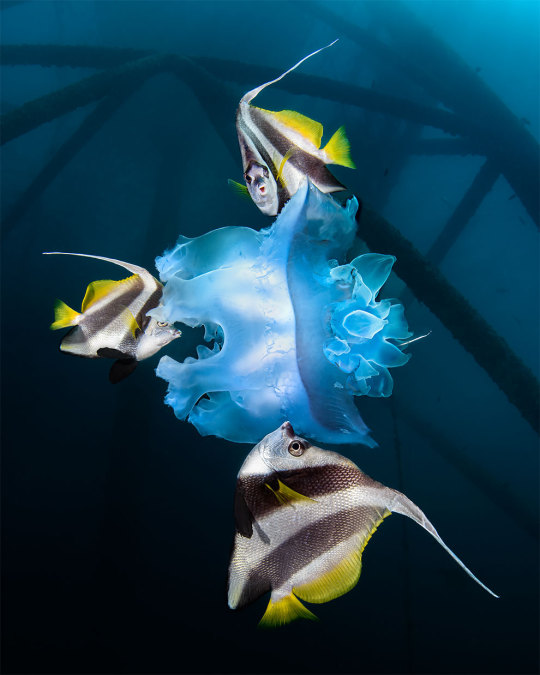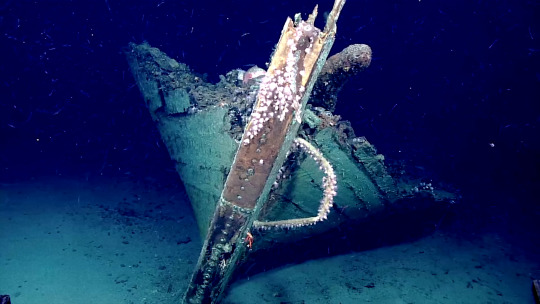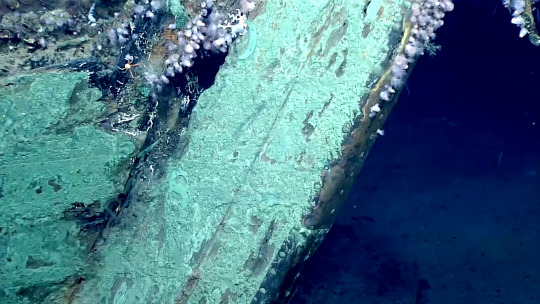#artificial reef
Explore tagged Tumblr posts
Text
Vaughan Williams - Fantasia on a Theme by Thomas Tallis
youtube






Photos of the SS United States on her final voyage at sea, somewhere off the coast of North Carolina. Taken by the captain of the tug "Vinik." Thank you David Silver for allowing me access. It's hard to believe this ghostly vessel is the very same ocean liner that once plowed through the North Atlantic at over 40 miles per hour, carrying 2,000 passengers in safety and luxury. She's now making 6.5 knots and his handling the rough seas quite well in spite of being 72 years old, a testament to her superb construction and design. If you squint, you can imagine her tearing through the ocean again.
Even in her watery funeral cortege, she remains proud and magnificent.
54 notes
·
View notes
Text







So yeah. The big news pulled me out of hiatus. If you haven't heard, the SS United States was on the move. After 30 years of sitting in limbo in Philadelphia, the plug has finally been pulled on the old liner. She will be sunk 30 miles offshore of Okaloosa Island in Florida to create an artificial reef for diving.
Under tow, the SS United States left Philly on Feb. 19 and traveled down the east coast of America, around the Florida coast, and then, keeping in tradition with being the fastest liner ever built, docked in Mobile, Alabama a few days ahead of schedule on March 3.
Over the following year, she will have her masts and cranes removed, all the paint will be sand blasted off, the boilers and engines will probably have to come out, her aluminum funnels and possibly parts of her superstructure will be saved for a future museum, but all other aluminum will have to be removed, and holes will have to be cut into her watertight compartments to ensure she sinks on an even keel.
It's a sad end, but at least it's better than being scrapped.
Source: (x)
#ocean liners#ships#boats#travel#ss united states#united states#sinking#reef#coral reef#artificial reef#diving#towing#tugboat#rusty#scrap#faded#old#weathered#at sea#sea#ocean
47 notes
·
View notes
Text

Kuwait, 2022.
This photo was taken at the remote oil rigs site in Kuwaiti waters, east of Qaruh Island. The inactive oil rigs have come to represent an important artificial reef in Kuwait, attracting divers and fishers alike.
Photo by Suliman Alatiqi
The Prince Albert II Of Monaco Foundation Environmental Photographer Of The Year 2023
Environmental Photography Award
#suliman alatiqi#photographer#environmental photography award#kuwait#qaruh island#artificial reef#reef#nature#black & white heniochus butterfly fish#fish#jellyfish
382 notes
·
View notes
Text


4 notes
·
View notes
Text
youtube
Every week, Eco India brings you stories that inspire you to build a cleaner, greener and better tomorrow.
A Goa-based NGO is helping to protect the marine environment with its adopt-a-coral scheme. Climate change, overfishing and pollution are destroying the area's reefs. The NGO Coastal Impact hopes to stop the decline with coral adoption.
**********
Credits:
Supervising Producer: Nooshin Mowla
Script and Field Producer: Bharat Mirle
Video Editor: Sujit Lad
Associate Producer: Ipsita Basu
Director of Photography: Mithun Bhat
Underwater Cinematographer: Ron Bezbaruah
Voiceover: Chandy Thomas
Production Assistant: Rebekah Awungshi
Executive Producer: Sannuta Raghu
#scroll.in#eco india#solarpunk#tidalpunk#india#coral#coral reef#artificial reef#marine life#ocean#sea#sea life#adopt a coral#Goa#NGO#climate change#overfishing#pollution#NGO Coastal Impact#coastal impact#Venkatesh Charloo#Youtube
8 notes
·
View notes
Text
as a hardcore tank nerd this is SO FUCKING COOL and as a hardcore lover of nature this is SO FUCKING COOL
So.
Y'all know that one meme of the tank being dumped off the ship saying "I go kill submarine for the motherland"?
If not, here it is:

The origins behind this image are utterly fascinating.
This is not a soviet built tank despite what the meme implies, it is actually a chinese built tank, a T-69-2 to be more specific.
What you don't see in the image are the further 24 tanks that are also on the barge about to dropped into the water as well.
These tanks are being dropped in on personal orders by Queen Sirikit, the queen mother of thailand.
No, for those worried, this was not them discarding old unusable tanks, at least in this instance. Rather, each of these tanks have selected and prepared to make an artificial reef. Rather than melt them down for scrap, in 2010 there were pushed into the water off the gulf of siam to create a home for hundreds of sea creatures. All the internals are gutted, including the engine and transmission, don't worry.
If you looks a little closer into the image, you'll see that all the hatches are open or removed, probably to make room for sea life.
If you want anymore info, I'd suggest checking out ConeOfArc over on youtube, he has a lot more on this and many more fascinating subjects such as the origins behind the panzer of the lake.
Y'all find this as cool as I do, right? Like, this shit is just so damn cool. As a wee bit of a tank nerd, it does make me sad that these are being dumped never to be seen again, but at least they're still being used for something rather than being turned into tin cans.
71K notes
·
View notes
Text
🐠 Coral Reefs Are in Trouble — But Divers Can Help 🌍
As climate change and coral reefs collide, marine ecosystems are collapsing under the pressure of warming seas and pollution. 😢
But there’s hope. In this post, discover how conscious divers are: ✅ Reducing their impact ✅ Choosing sustainable gear ✅ Supporting coral restoration projects
🧜♂️ The ocean needs defenders. Ready to take action?
📎 Click the Link below to read the full article.

#scuba#scubadiving#scubagirls#scubaguys#scubalife#scuba gear#scubalove#scubaworld#diving#the_eagle_ray_dive_shop#climate change#climate crisis#climate action#climate activism#global warming#environment#climate justice#fossil fuels#artificial reef#coral reef#reef#ecofriendly#sustainability
1 note
·
View note
Text
Final Voyage
SS United States being moved to Pier 80. The day many of us never wanted to see is now upon us. The SS United States is in final preparation to be towed to Mobile, Alabama, for a year-long conversion to prepare the great liner for reefing. Last week she was moved from Pier 82, a place she has called home since 1996, to the adjacent Pier 80. When her stern was turned towards the pier the majestic…
#artificial reef#Blue Riband#Cold War#Dubai#Florida#Netherlands#ocean liner#Okaloosa County#Queen Elizabeth 2#RMS Olympic#RMS Queen Mary#RMS Titanic#SOS United States#SS Rotterdam#SS United States Conservancy#White Swan Hotel
1 note
·
View note
Text
We really loved this dive. It's so much fun when the fish are really interactive and sergeant major fish never disappoint.
Join us for the full video of this wrecked plane turn reef at Normans Cay 🤿✈🐟⚓⛵ https://youtu.be/0a8_HRslMvs or Extended, UnCensored, OnDemand https://vimeo.com/ondemand/sailingdarkangel/1041776631
follow us for more sailing, snorkelling, diving, exploring
#adventure#saltlife#darkangel#catamaran#sailing#youtubechannel#bahamas#youtube#stingray#planewreck#artificial reef
1 note
·
View note
Text


#Into the Abyss: Chemosynthetic Oases#deep sea#ship wreck#artificial reef#wood fall#ocean aesthetic#o
1 note
·
View note
Text




#octonauts#captain barnacles#kwazii octonauts#octonauts shellington#octonauts tweak#octonauts tunip#Artificial Reef Episode#I had to add all four because these go hard#that’s all for now!!#until next time rahhhhhh 👹
25 notes
·
View notes
Text
🌊 How Artificial Reefs Promote Marine Biodiversity 🌱🐠
Artificial reefs aren’t just man-made structures — they’re lifelines for our oceans. 🌎💙
From restoring coral reefs to rebuilding marine ecosystems, artificial reefs promote marine biodiversity by creating safe habitats for countless species. 🐟🪸
👉 Dive into data-driven benefits, inspiring real-world success stories, and practical reef-building tips that are making waves in conservation. 🌊💪
✅ Click the Link Below! Let’s work together to protect and rebuild ocean life. 🌱

#scuba#scubadiving#scubagirls#scubaguys#scubalife#scuba gear#scubalove#scubaworld#diving#the_eagle_ray_dive_shop#artificial reef#marine conservation#marine life#marinette dupain cheng#marine biology#coral reef#save our seas#ocean life
1 note
·
View note
Text
Space under water...

We are looking for life on other planets without knowing our own home - Earth. Most of the unknown species live in the depths of the seas and oceans. Most waters body of them are slowly turning into plastic landfills (microplastics are probably already present in our bodies). It is always worth thinking about how many plastic things we have to use because it would be nice to know this real space on Earth, before we managed to destroy it.

#underwater#angelfish#ai#ai art#ai artwork#ai generated#artificial intelligence#bandcamp#ai video#coral reef#sea animals#ambient#fish#garbage#music#ecology#ecosystem#eco#plastic#Bandcamp
7 notes
·
View notes
Text
Coral restoration efforts usually involve transplanting tiny corals, cultivated in nurseries, on to damaged reefs.
However the work can be slow and costly, and only a fraction of the reefs at risk are getting help.
In the shallow waters of the Abrolhos Islands, [Marine biologist Taryn Foster] is testing a system she hopes will revive reefs more quickly...
It involves grafting coral fragments into small plugs, which are inserted into a moulded base. Those bases are then placed in batches on the seabed....
Ms Foster has formed a start-up firm called Coral Maker and hopes that a partnership with San Francisco-based engineering software firm Autodesk will accelerate the process further.
Their researchers have been training an artificial intelligence to control collaborative robots (cobots), which work closely alongside humans.
"Some of these processes in coral propagation are just repetitive pick and place tasks, and they're ideally suited to robotic automation," says Ms Foster.
A robotic arm can graft or glue coral fragments to the seed plugs. Another places them in the base, using vision systems to make decisions about how to grab it.
"Every piece of coral is different, even within the same species, so the robots need to recognise coral fragments and how to handle them," says Nic Carey, senior principal research scientist at Autodesk.
"So far, they're very good at handling the variability in coral shapes."
75 notes
·
View notes
Text

Of Muggy Days, November 2015
6 notes
·
View notes